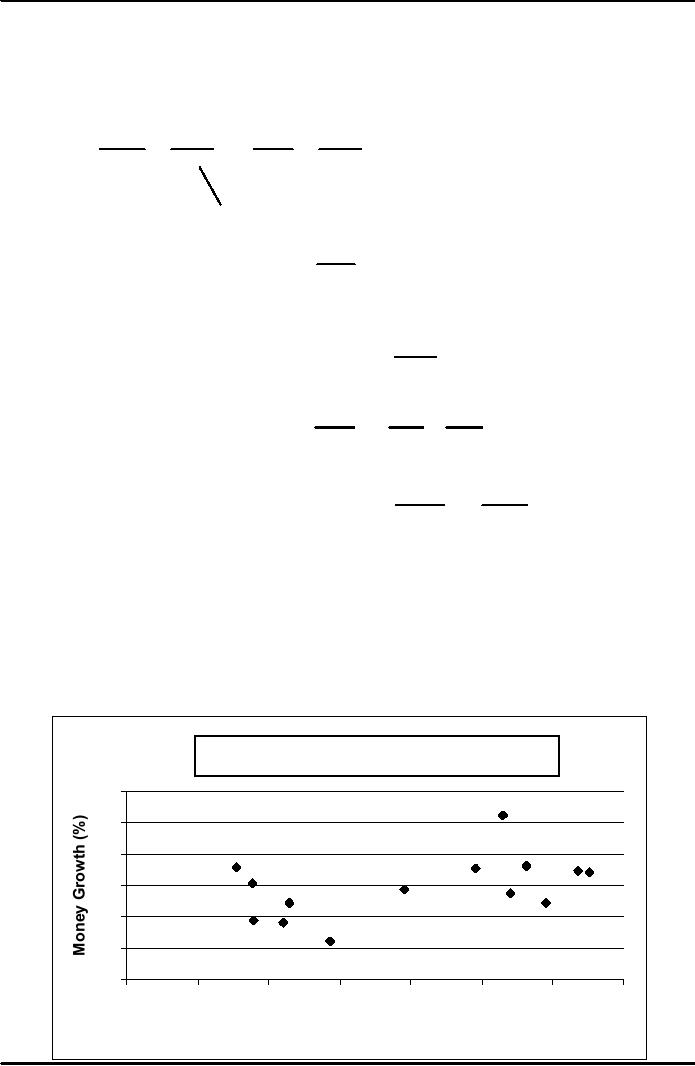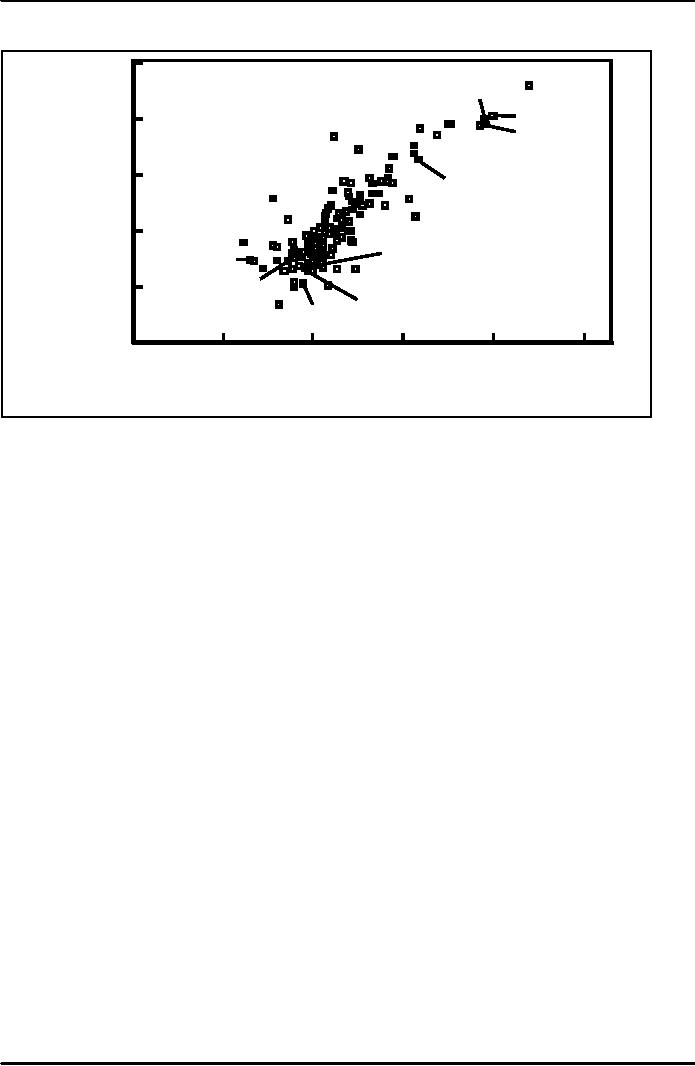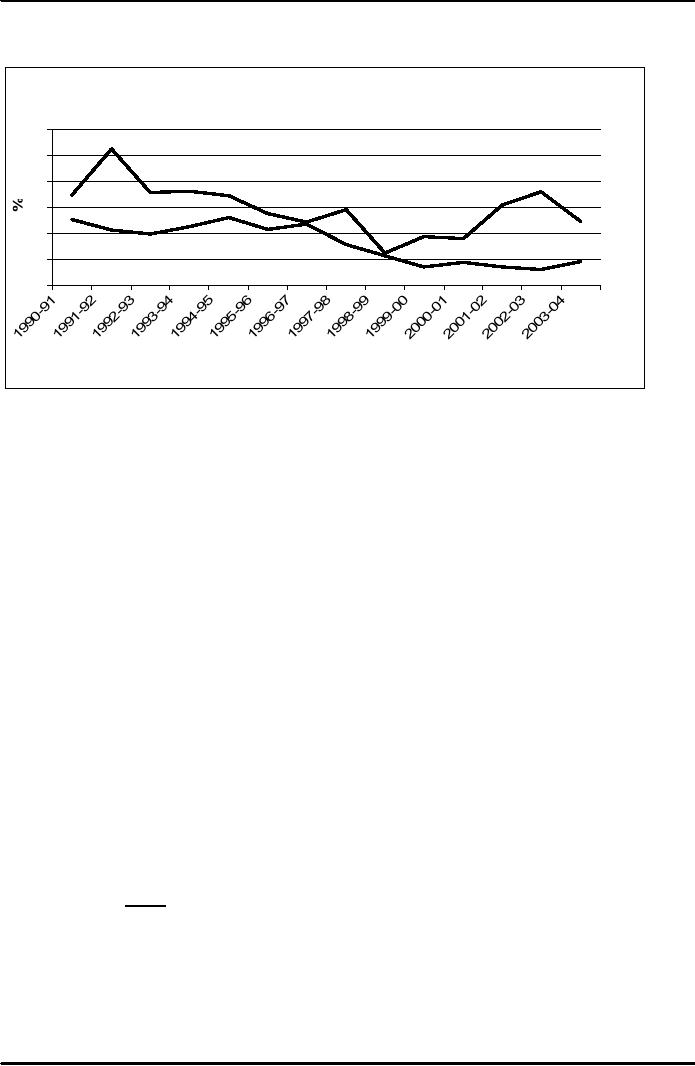 |

Macroeconomics
ECO 403
VU
LESSON
11
MONEY AND
INFLATION
Money
supply measures
_
Symbol
Assets
included___________
C
Currency
M1
C
+ demand deposits,
travelers'
checks,
other
checkable deposits
M2
M1
+ small time
deposits,
savings
deposits,
money
market mutual funds,
money
market deposit
accounts
M3
M2
+ large time
deposits,
repurchase
agreements,
institutional
money market
mutual
fund balances
The
Quantity Equation
·
The
quantity equation
M
×V
= P ×Y
follows
from the preceding
definition of velocity.
It is an
identity:
it
holds by definition of the
variables.
Money
demand and the quantity
equation
·
Let's
now express the quantity of
money in terms of the
quantity of goods and
services
it
can buy;
·
M/P = real
money balances,
the
purchasing power of the
money supply.
·
A
simple money demand
function:
(M/P
)d =
k Y
where
k
= how much money people
wish to hold for each
rupee of income (k is
exogenous)
·
This
equation states that the
quantity of real money
balances demanded is
proportional
to
real income.
·
(M/P
)d =
k Y
Money
demand:
·
Quantity
equation: M ×V = P ×Y
·
The
connection between them: k =
1/V
·
When
people hold lots of money
relative to their incomes (k is
high), money changes
hands
infrequently (V is low).
37

Macroeconomics
ECO 403
VU
THE
QUANTITY THEORY OF
MONEY
·
Recall
The
growth rate of a product
equals the sum of the
growth rates.
·
The
quantity equation in growth
rates:
ΔM
ΔV
ΔP
ΔY
+
=
+
M
V
P
Y
The
quantity theory of money
assumes
ΔV
V
is
constant, so
=
0.
V
Let
š
(Greek
letter "pi") denote the
inflation rate:
ΔP
š =
P
ΔM
ΔP
ΔY
We
have
=
+
M
P
Y
ΔM
ΔY
Solve
this result for š
to
get
š =
-
M
Y
·
Normal
economic growth requires a
certain amount of money
supply growth to
facilitate
the
growth in transactions.
·
Money
growth in excess of this
amount leads to
inflation.
ΔY/Y depends on
growth in the factors of
production and on technological
progress (all of
which
we take as given, for
now).
Hence,
the Quantity Theory of Money
predicts a one-for-one relation
between changes in
the
money
growth rate and changes in
the inflation rate.
Inflation
and Money growth
Inflation
and Money Growth of
Pakistan
30
1991-92
25
1993-94
1990-91
20
1992-93
2002-03
1994-95
2001-02
1997-98
2003-04
1995-96
15
1999-00
1996-97
2000-01
10
1998-99
5
0
0
2
4
6
8
10
12
14
Inflation
(%)
38

Macroeconomics
ECO 403
VU
International
data on inflation and money
growth
10,000
Republic
.
Inflation
rate
of
Congo
Nicaragua
(%)(Log
scale)
Angola
1,000
Georgia
Brazil
100
Bulgaria
10
Germany
Kuwait
1
USA
Canada
Oman
Japan
0.1
0.1
1
10
100
1,000
10,000
Money
supply growth(%)
Log
scale
39

Macroeconomics
ECO 403
VU
Inflation
and Money growth in
Pakistan
30
25
20
Money
Growth (M2)
15
10
5
0
Inflation
rate
Years
SEIGNIORAGE
·
To
spend more without raising
taxes or selling bonds, the
govt. can print
money.
·
The
"revenue" raised from
printing money is called
seigniorage
(pronounced
SEEN-your-ige)
·
The
inflation tax:
Printing
money to raise revenue
causes inflation. Inflation is
like a tax on people
who
hold
money.
Inflation
and interest
rates
·
Nominal
interest rate, i
not
adjusted for
inflation
·
Real
interest rate, r
adjusted
for inflation:
r=i
-š
The
Fisher Effect
·
The
Fisher equation:
i=r+š
·
S = I determines
r.
·
Hence, an
increase in š
causes
an equal increase in i.
·
This
one-for-one relationship
is
called the Fisher
effect.
40
Table of Contents:
- INTRODUCTION:COURSE DESCRIPTION, TEN PRINCIPLES OF ECONOMICS
- PRINCIPLE OF MACROECONOMICS:People Face Tradeoffs
- IMPORTANCE OF MACROECONOMICS:Interest rates and rental payments
- THE DATA OF MACROECONOMICS:Rules for computing GDP
- THE DATA OF MACROECONOMICS (Continued…):Components of Expenditures
- THE DATA OF MACROECONOMICS (Continued…):How to construct the CPI
- NATIONAL INCOME: WHERE IT COMES FROM AND WHERE IT GOES
- NATIONAL INCOME: WHERE IT COMES FROM AND WHERE IT GOES (Continued…)
- NATIONAL INCOME: WHERE IT COMES FROM AND WHERE IT GOES (Continued…)
- NATIONAL INCOME: WHERE IT COMES FROM AND WHERE IT GOES (Continued…)
- MONEY AND INFLATION:The Quantity Equation, Inflation and interest rates
- MONEY AND INFLATION (Continued…):Money demand and the nominal interest rate
- MONEY AND INFLATION (Continued…):Costs of expected inflation:
- MONEY AND INFLATION (Continued…):The Classical Dichotomy
- OPEN ECONOMY:Three experiments, The nominal exchange rate
- OPEN ECONOMY (Continued…):The Determinants of the Nominal Exchange Rate
- OPEN ECONOMY (Continued…):A first model of the natural rate
- ISSUES IN UNEMPLOYMENT:Public Policy and Job Search
- ECONOMIC GROWTH:THE SOLOW MODEL, Saving and investment
- ECONOMIC GROWTH (Continued…):The Steady State
- ECONOMIC GROWTH (Continued…):The Golden Rule Capital Stock
- ECONOMIC GROWTH (Continued…):The Golden Rule, Policies to promote growth
- ECONOMIC GROWTH (Continued…):Possible problems with industrial policy
- AGGREGATE DEMAND AND AGGREGATE SUPPLY:When prices are sticky
- AGGREGATE DEMAND AND AGGREGATE SUPPLY (Continued…):
- AGGREGATE DEMAND AND AGGREGATE SUPPLY (Continued…):
- AGGREGATE DEMAND AND AGGREGATE SUPPLY (Continued…)
- AGGREGATE DEMAND AND AGGREGATE SUPPLY (Continued…)
- AGGREGATE DEMAND AND AGGREGATE SUPPLY (Continued…)
- AGGREGATE DEMAND IN THE OPEN ECONOMY:Lessons about fiscal policy
- AGGREGATE DEMAND IN THE OPEN ECONOMY(Continued…):Fixed exchange rates
- AGGREGATE DEMAND IN THE OPEN ECONOMY (Continued…):Why income might not rise
- AGGREGATE SUPPLY:The sticky-price model
- AGGREGATE SUPPLY (Continued…):Deriving the Phillips Curve from SRAS
- GOVERNMENT DEBT:Permanent Debt, Floating Debt, Unfunded Debts
- GOVERNMENT DEBT (Continued…):Starting with too little capital,
- CONSUMPTION:Secular Stagnation and Simon Kuznets
- CONSUMPTION (Continued…):Consumer Preferences, Constraints on Borrowings
- CONSUMPTION (Continued…):The Life-cycle Consumption Function
- INVESTMENT:The Rental Price of Capital, The Cost of Capital
- INVESTMENT (Continued…):The Determinants of Investment
- INVESTMENT (Continued…):Financing Constraints, Residential Investment
- INVESTMENT (Continued…):Inventories and the Real Interest Rate
- MONEY:Money Supply, Fractional Reserve Banking,
- MONEY (Continued…):Three Instruments of Money Supply, Money Demand